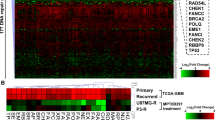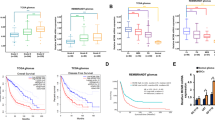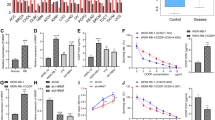Abstract
The Holliday Junction-Recognition Protein (HJURP) was reported as overexpressed in several cancers and also strongly correlated with poor prognosis of patients, especially in glioblastoma (GBM), the most common and deadly type of primary brain tumor. HJURP is responsible for loading the histone H3 variant—the Centromeric Protein A (CENP-A)—at the centromeres in a cell cycle-regulated manner, being required for proper chromosome segregation. Here we investigated HJURP association with survival and radioresistance of different GBM cell lines. HJURP knockdown compromised the clonogenic capacity and severely impaired survival of five distinct GBM cells, while nontumor astrocytes were not affected. U251MG cells showed a robust cell cycle arrest in G2/M phases followed by a drastic increment in cell death after HJURP silencing, while U138MG and U343MG cell lines presented augmented senescence with a comparable increase in cell death. Importantly, we verified that the impact on cell cycle dynamics and clonogenic survival were associated with loss CENP-A at the centromeres. Moreover, radiation resistance was also impacted by HJURP modulation in several GBM cell lines. U87MG, T98G, U138MG, and U343MG cells were all sensitized to ionizing radiation after HJURP reduction. These data reinforce the requirement of HJURP for proliferative capacity and radioresistance of tumor cells, underlining its potential as a promising therapeutic target for GBM.
This is a preview of subscription content, access via your institution
Access options
Subscribe to this journal
Receive 12 print issues and online access
$259.00 per year
only $21.58 per issue
Buy this article
- Purchase on Springer Link
- Instant access to full article PDF
Prices may be subject to local taxes which are calculated during checkout







Similar content being viewed by others
References
Dunleavy EM, Roche D, Tagami H, Lacoste N, Ray-Gallet D, Nakamura Y, et al. HJURP Is a cell-cycle-dependent maintenance and deposition factor of CENP-A at centromeres. Cell. 2009;137:485–97.
Foltz DR, Jansen LE, Bailey AO, Yates JR 3rd, Bassett EA, Wood S, et al. centromere-specific assembly of CENP-A nucleosomes is mediated by HJURP. Cell. 2009;137:472–84.
Müller S, Montes de Oca R, Lacoste N, Dingli F, Loew D, Almouzni G. Phosphorylation and DNA binding of HJURP determine its centromeric recruitment and function in CenH3CENP-A loading. Cell Rep. 2014;8:190–203.
Sekulic N, Black BE. Molecular underpinnings of centromere identity and maintenance. Trends Biochem Sci. 2012;37:220–29.
Kato T, Sato N, Hayama S, Yamabuki T, Ito T, Miyamoto M, et al. Activation of holliday junction-recognizing protein involved in the chromosomal stability and immortality of cancer cells. Cancer Res. 2007;67:8544–53.
Maehara K, Takahashi K, Saitoh S. CENP-A reduction induces a p53-Dependent cellular senescence response to protect cells from executing defective mitoses. Mol Cell Biol. 2010;30:2090–104.
Heo JI, Cho JH, Kim JR. HJURP regulates cellular senescence in human fibroblasts and endothelial cells via a p53-dependent pathway. J Gerontol Ser A Biol Sci Med Sci. 2013;68:1–12.
Hu Z, Huang G, Sadanandam A, Gu S, Lenburg ME, Pai M, et al. The expression level of HJURP has an independent prognostic impact and predicts the sensitivity to radiotherapy in breast cancer. Breast Cancer Res. 2010;12:R18.
Hu B, Wang Q, Wang Y, Chen J, Li P, Han M. Holliday junction – recognizing protein promotes cell proliferation and correlates with unfavorable clinical outcome of hepatocellular carcinoma. Onco Targets Ther. 2017;10:2601–7.
Li L, Li X, Meng Q, Khan AQ, Chen X. Increased expression of holliday junction- recognizing protein (HJURP) as an independent prognostic biomarker in advanced-stage serous ovarian carcinoma. Med Sci Monit. 2018;24:3050–5.
Valente V, Serafim RB, de Oliveira LC, Adorni FS, Torrieri R, Tirapelli DP, et al. Modulation of HJURP (Holliday Junction-Recognizing Protein) levels is correlated with glioblastoma cells survival. PLoS ONE. 2013;8:e62200.
Adamson C, Kanu OO, Mehta AI, Di C, Lin N, Mattox AK, et al. Glioblastoma multiforme: a review of where we have been and where we are going. Expert Opin Invest Drugs. 2009;18:1061–83.
Jansen M, Yip S, Louis DN. Molecular pathology in adult gliomas: diagnostic, prognostic, and predictive markers. Lancet Neurol. 2010;9:717–26.
Brandes AA, Ermani M, Basso U, Amistà P, Berti F, Scienza R, et al. Temozolomide as a second-line systemic regimen in recurrent high-grade glioma: a phase II study. Ann Oncol. 2001;12:255–57.
Martinez R, Rohde V, Schackert G. Different molecular patterns in glioblastoma multiforme subtypes upon recurrence. J Neurooncol. 2010;96:321–29.
Parsons DW, Jones S, Zhang X, Lin JC, Leary RJ, Angenendt P, et al. An integrated genomic analysis of human glioblastoma multiforme. Science. 2008;321:1807–12.
Ishii N, Maier D, Merlo A, Tada M, Sawamura Y, Diserens AC, et al. Frequent co-alterations of TP53, p16/CDKN2A, p14ARF, PTEN tumor suppressor genes in human glioma cell lines. Brain Pathol. 1999;479:469–79.
Barnhart MC, Kuich PH, Stellfox ME, Ward JA, Bassett EA, Black BE, et al. HJURP Is a CENP-A chromatin assembly factor sufficient to form a functional de novo kinetochore. J Cell Biol. 2011;194:229–43.
Barnhart-Dailey MC, Trivedi P, Stukenberg PT, Foltz DR. HJURP interaction with the condensin II complex during G1 promotes CENP-A deposition. Mol Biol Cell. 2017;28:54–64.
Mishra PK, Au WC, Choy JS, Kuich PH, Baker RE, Foltz DR, et al. Misregulation of Scm3p/HJURP causes chromosome instability in saccharomyces cerevisiae and human cells. PLoS Genet. 2011;7:e1002303.
Perpelescu M, Hori T, Toyoda A, Misu S, Monma N, Ikeo K, et al. HJURP is involved in the expansion of centromeric chromatin. Mol Biol Cell. 2015;26:2742–54.
Adams RR, Carmena M, Earnshaw WC. Chromosomal passengers and the (Aurora) ABCs of mitosis. Trends Cell Biol. 2001;11:49–54.
Nigg EA. Mitotic kinases as regulators of cell division and its checkpoints. Nat Rev Mol Cell Biol. 2001;2:21–32.
Keen N, Taylor S. Aurora-kinase inhibitors as anticancer agents. Nat Rev Cancer. 2004;4:927–36.
Martens-de Kemp SR, Nagel R, Stigter-van Walsum M, van der Meulen IH, van Beusechem VW, Braakhuis BJ, et al. Functional genetic screens identify genes essential for tumor cell survival in head and neck and lung cancer. Clin Cancer Res. 2013;19:1994–2003.
Chen C, Iavarone P, Fick A, Edwards J, Prados M, Israel MA. Constitutional p53 mutations associated with brain tumors in young adults. Cancer Genet Cytogenet. 1995;82:106–15.
Acknowledgements
The authors acknowledge Silvia Regina Andrade Nascimento for technical assistance, Fabiana Rossetto de Morais for flow cytometry analyses and Douglas Elias Santos for graphic art support in the illustration production.
Funding statement
VV was supported by the Fundação de Amparo à Pesquisa do Estado de São Paulo—FAPESP (grant #2013/13465–1; grant #2018/05018–9), Programa de Apoio ao Desenvolvimento Científico—PADC (grant no. 256/2017) from the Faculty of Pharmaceutical Sciences of Araraquara and by the Center for Cell-Based Therapy (CEPID/FAPESP; grant #2013/08135–2). RBS and LFMDC received fellowships from the Coordenação de Aperfeiçoamento de Pessoal de Nível Superior—CAPES. CC received fellowships from the Conselho Nacional de Desenvolvimento Científico e Tecnológico—CNPq.
Author information
Authors and Affiliations
Contributions
Conceptualization: VV and RBS; Investigation: RBS, CC, and LFMDC; Funding acquisition: VV, CPS, WASJr, EME, and MLPL; Data analysis and writing: RBS., BDP and VV.
Corresponding author
Ethics declarations
Conflict of interest
The authors declare that they have no conflict of interest.
Additional information
Publisher’s note: Springer Nature remains neutral with regard to jurisdictional claims in published maps and institutional affiliations.
Rights and permissions
About this article
Cite this article
Serafim, R.B., Cardoso, C., Di Cristofaro, L.F.M. et al. HJURP knockdown disrupts clonogenic capacity and increases radiation-induced cell death of glioblastoma cells. Cancer Gene Ther 27, 319–329 (2020). https://doi.org/10.1038/s41417-019-0103-0
Received:
Accepted:
Published:
Issue Date:
DOI: https://doi.org/10.1038/s41417-019-0103-0
This article is cited by
-
Establishing a prognostic model of chromatin modulators and identifying potential drug candidates in renal clear cell patients
BMC Bioinformatics (2023)
-
HJURP regulates cell proliferation and chemo-resistance via YAP1/NDRG1 transcriptional axis in triple-negative breast cancer
Cell Death & Disease (2022)



